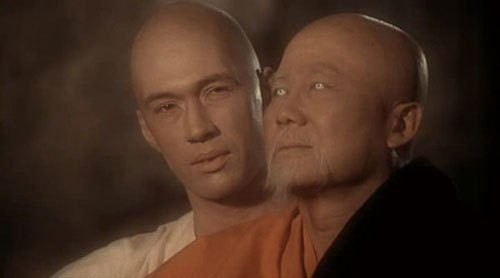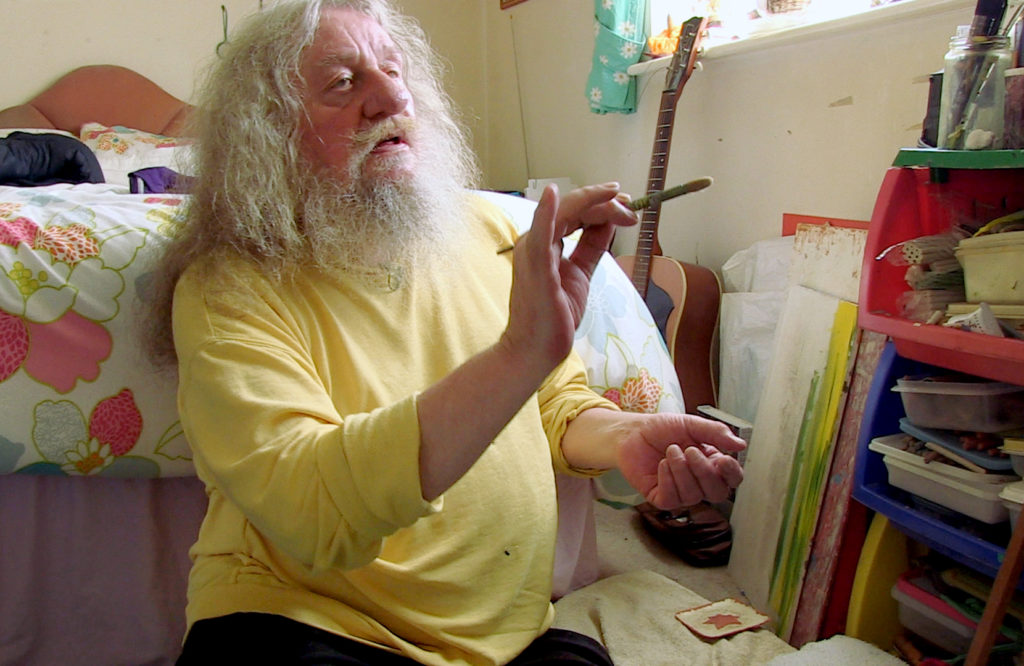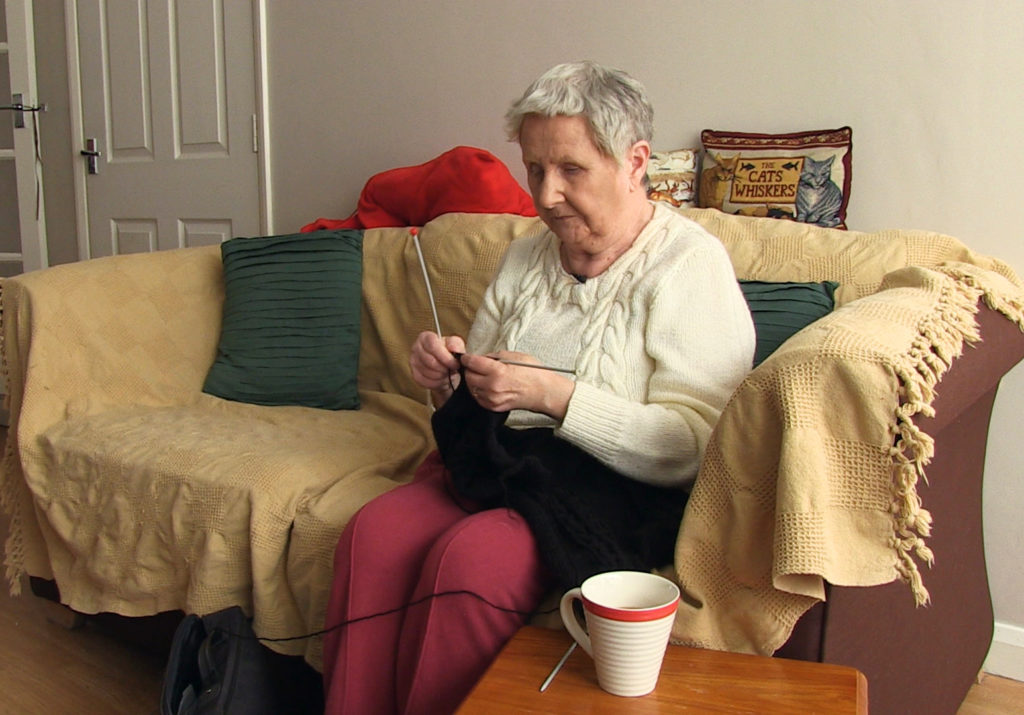This research project aims to deconstruct the stigma of blind people through the analysis of existing, as well as the consideration of new, non-stereotypical media representations. It has established partnerships with stakeholder organisations and individuals, in order to pursue different pathways for social impact, based on my research-led practice that has produced two feature documentaries, The Terry Fragments and June’s Patchwork.
The Terry Fragments (website) – Trailer:
Synopsis: For many, becoming blind embodies a life-changing trauma but for Terry, he continues to paint, write short stories and play guitar all in his crowded small apartment with his long-time partner Pamela. Terry’s home is a treasure trove, a collection of unseen and fascinating paintings, drawings, and notebooks, not to mention Terry himself, a character worthy of his own TV show. Over five years, this film captures the raw and everyday of Terry’s life, during which he turns out to be mischievous, funny, utterly resilient and fiercely protective of his cigarette breaks.
June’s Patchwork (website) – Trailer:
Synopsis: Since losing her sight June has pursued her dreams to become a writer, historian, a disability access auditor, and a legal consultant, all from her small English coastal town. The film captures raw snapshots of June’s everyday life, including moments listening to the large ferries arriving from Holland, spending time with her medieval garden wall, and long walks with her beloved partner David. This gives viewers time and space to intimately experience June’s joie de vivre and her seeing blindness as a second life stage.
PROJECT CONTEXT
Whether in art, literature or media, blind people have been consistently represented as either unfortunate, disabled and deprived (figure 1), or as exotic, mysterious and in touch with the supernatural (figure 2). This depiction of the blind person as the “abnormal other” is the symptom and, at the same time, partial cause for prejudicial attitudes and practices held by non-blind, and especially non-disabled, people.
Figure 1: The Blind Leading the Blind (painted in 1568 by Pieter Brueghel the Elder)
Figure 2: Master Po in Kung Fu (1972-1975)
This stigma manifests as patronising and ostracising, ableist attitudes about blind people, which has negatively affected inclusion, access, policy-making, support mechanisms and social welfare. It has also negatively impacted on the self-esteem and social performance of blind people. These negative consequences can be reduced by identifying and reducing particular media stereotypes that ‘other’ blind people, thus reducing social stigma. This could trigger a societal shift toward accepting blind people as valued members of a diverse society.
My films The Terry Fragments and June’s Patchwork attempt to reduce ‘othering’ stereotypes through adopting a ‘critical film practice’, using methods from film studies, disability studies, social cognition studies, phenomenology and anthropology to better understand the possible social impact of narrative and aesthetic representations in media. Strategies include the focus on the character’s intimate interactions with everyday objects:
Terry reflecting on his brush
June knitting
TARGET AUDIENCES
The films target five main audiences with different aims for social impact, which has been implemented through a range of partnerships with organisations and individuals:
1. Visual impairment groups: service users, support workers, charities
- Identifying opportunities for implementing media for wellbeing, awareness, empathy, etc.
- Being aware of stigmatising media representations and stereotype threat
- Empowerment through taking up arts and crafts
2. Clinical groups: clinicians, therapists, rehabilitation workers
- Increasing empathy towards the patient’s voice and experience
- Deviating from the medical model
3. Research groups: researchers in visual impairment and disability contexts (cultural studies, media studies, anthropology, psychology, art therapy, medicine, etc.)
- Identifying underrepresented areas for further research
- Encouraging knowledge exchange with stakeholders outside the academy
4. Media groups: commissioning editors, producers, writers, film directors, film students, etc.
- Acquiring a critical media literacy to understand the mechanisms of media stereotypes and social stigma
- Using media to break stigmatising stereotypes
5.General public
- Reconfiguring stereotypes and reducing overall public stigma
- Adjusting prejudice and behaviour towards blind people
PUBLIC ENGAGEMENT
Dr. Catalin Brylla on Documentary and Disability – Community podcast for RIIVE – Darren Gormley and Catalin Brylla discuss the curious relationship between documentary and disability
Breaking Blind Stereotypes in Life & in Media – RNIB Connect Radio podcast series on disability stereotypes and social stigma – recommended by the Radio Times.
Pilot ¦ Episode 1 ¦ Episode 2 ¦ Episode 3
PUBLICATIONS (as part of this project)
A Social Cognition Approach to Stereotyping in Documentary (2018)
Bypassing the Supercrip Trope in Documentary Representations of Blind Visual Artists (2018)
Documentary and Disability (2017)
Spectatorship and Alternative Portrayals of Blindness (2017)
PUBLICATIONS (others)
Seeing with the Hands: Blindness, Vision and Touch After Descartes (2016, Mark Paterson)
Othering Blindness – On Modern Epistemological Politics (Michael Schillmeier, 2006)
Blindness: The History of a Mental Image in Western Thought (2001, Moshe Barasch)
DISABILITY REPRESENTATION IN MEDIA
The Art of Disability: A handbook about Disability Representation in Media (2016, David Proud)
Disability and the Media (2015, Katie Ellis (Author), Gerard Goggin)
Different Bodies: Essays on Disability in Film and Television (2013, edited by Marja Evelyn Mogk)
Representing Disability in an Ableist World: Essays on Mass Media (2010, Beth Haller)
The Problem Body: Projecting Disability on Film (2010, edited by Sally Chivers and Nicole Markotic)
Disability and the Media: Prescriptions for Change (2005, Charles A. Riley)
The Cinema of Isolation: A History of Physical Disability in the Movies (2994, Martin F. Norden)



